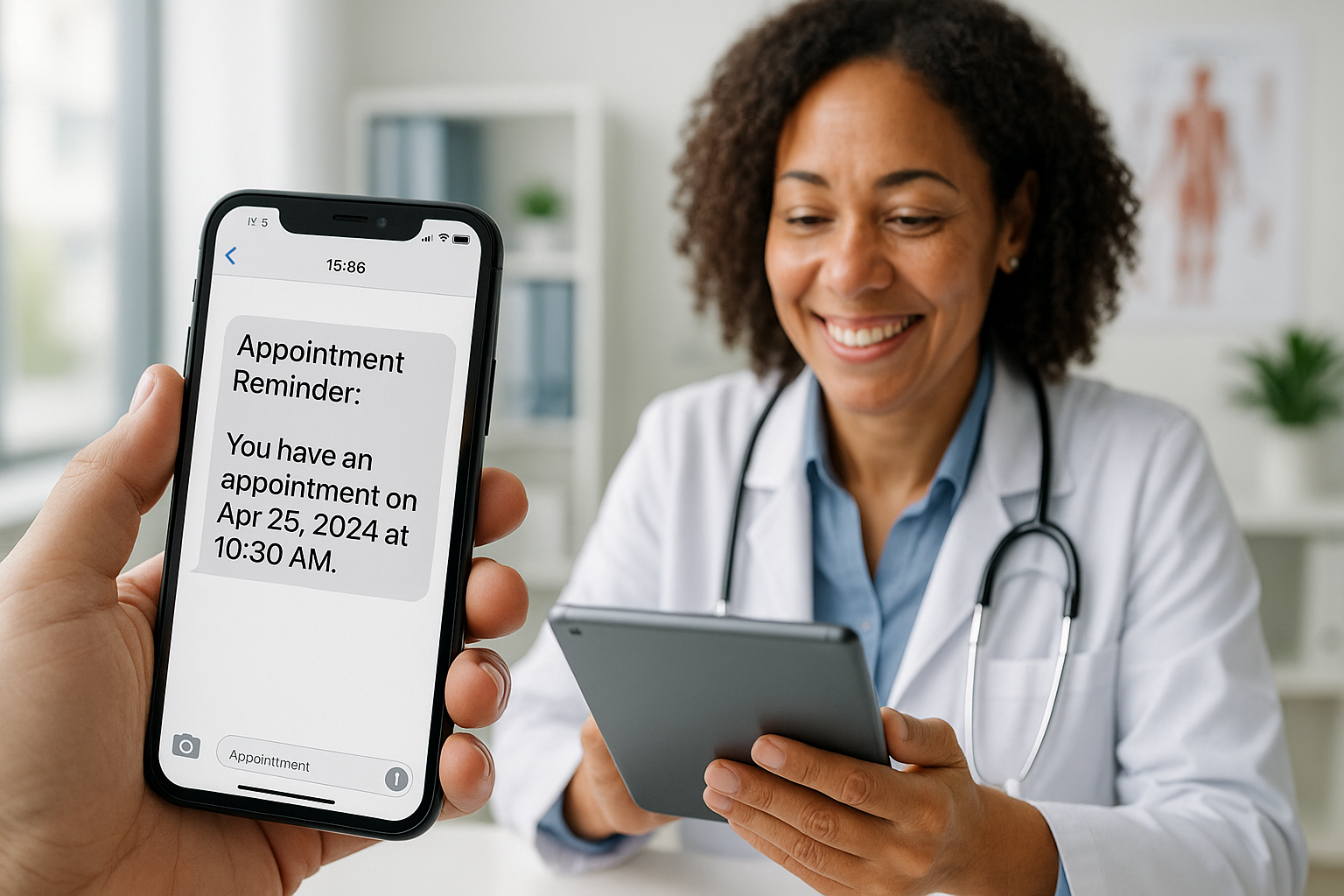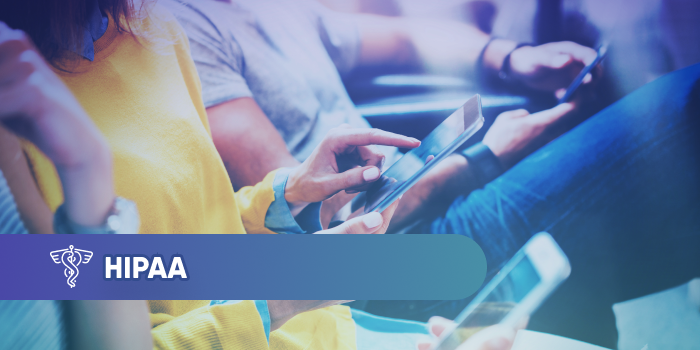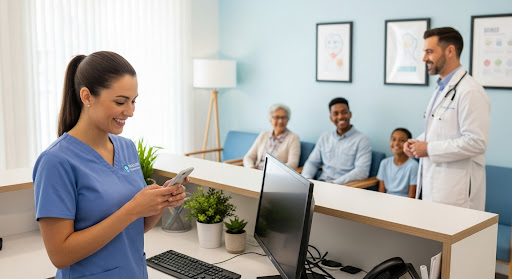10 min read
15 Transformative Benefits of Text Messaging in Healthcare
Alvin Amoroso : 7/2/25 9:26 PM

In an era where instant communication is not just a convenience but an expectation, the healthcare industry is rapidly adapting. The simple, ubiquitous nature of text messaging presents a monumental opportunity to enhance patient care, streamline operations, and improve outcomes. For healthcare providers, understanding and implementing text messaging in healthcare is no longer a futuristic concept but a present-day necessity. This comprehensive guide explores the profound impact of healthcare text messaging, from its transformative benefits to the critical steps for secure and compliant integration.
What is Text Messaging in Healthcare?
Text messaging in healthcare is the use of SMS (Short Message Service) and secure messaging applications by providers to communicate with patients and staff for administrative and clinical purposes. It is used to send appointment reminders, deliver lab result notifications, promote medication adherence, share health education, and facilitate quick internal team communication. The primary purpose of this form of healthcare texting is to improve communication efficiency, boost patient engagement, reduce administrative burdens, and ultimately enhance the quality and delivery of patient care in a secure, compliant, and convenient manner.
Deeper Insights into Text Messaging in Healthcare
For decades, communication between healthcare providers and patients has been a slow, often one-sided affair dominated by phone calls, voicemails, and paper mail. This traditional model is fraught with inefficiencies—missed calls, games of phone tag, and delays in receiving critical information. The introduction of text messaging in healthcare marks a pivotal shift towards a more dynamic, responsive, and patient-centric communication paradigm.
The statistics surrounding text messaging are staggering and underscore its potential. With open rates as high as 98%—compared to roughly 20% for email—text messages are almost guaranteed to be seen. Furthermore, the majority of these messages are read within minutes of being received. This immediacy is a powerful tool in a field where timely information can have a direct impact on a patient's health and well-being.
However, the adoption of texting in healthcare is not merely about speed; it's about meeting patients where they are. In 2025, virtually every patient owns a mobile phone, making SMS the most accessible and equitable form of digital communication available. It requires no special apps, no complex logins, and no steep learning curve. This simplicity breaks down barriers to access, ensuring that communication is not limited by a patient's technological proficiency.
This guide will navigate the multifaceted world of healthcare text messaging. We will delve into its numerous benefits, explore the critical challenges, particularly concerning HIPAA compliance, and provide a clear roadmap for successful implementation. By the end, you will have a thorough understanding of how to leverage this powerful tool to revolutionize your practice and foster stronger, more effective relationships with your patients.
15 Powerful Benefits and Use Cases of Healthcare Text Messaging
The practical applications of healthcare texting are vast and varied, touching nearly every aspect of the patient journey and internal operations. By integrating this technology, healthcare organizations can unlock significant improvements in efficiency, patient engagement, and financial performance. Here are 15 of the most impactful benefits and use cases.
1. Drastically Reduce Patient No-Shows
This is arguably the most immediate and financially impactful use case. Missed appointments cost the U.S. healthcare system over $150 billion annually. A simple, automated text reminder sent 24-48 hours before an appointment can dramatically reduce no-show rates by up to 36%.
- How it works: Automated systems send a personalized reminder with the date, time, and location. Patients can often confirm or cancel directly via text, allowing staff to fill vacant slots.
2. Boost Medication Adherence
Non-adherence to medication regimens is a major public health issue, leading to poor outcomes and increased healthcare costs. Healthcare text messaging serves as a simple and effective nudge.
- How it works: Send automated daily or weekly reminders for patients to take their medication. These can be customized for specific drugs and schedules, significantly improving compliance, especially for patients with chronic conditions.
3. Streamline Post-Discharge Follow-Up
The transition from hospital to home is a critical period. Timely follow-up can prevent readmissions and ensure a smooth recovery.
- How it works: Schedule a series of automated texts to check in on patients post-discharge. These messages can ask about their recovery, remind them of follow-up appointments, and provide a simple way to ask questions without needing to make a phone call.
4. Deliver Lab and Test Results Instantly
The anxiety of waiting for test results can be immense. Texting provides a secure and rapid way to deliver this information.
- How it works: For non-sensitive results or notifications that results are ready, a text can direct a patient to a secure portal. This reduces patient anxiety and frees up staff from making countless phone calls.
5. Enhance Internal Team Communication
Texting in healthcare isn't just for patients. Secure messaging platforms allow for instant and HIPAA-compliant communication between clinicians and staff.
- How it works: Doctors, nurses, and administrative staff can quickly coordinate patient care, share updates, manage shift changes, and consult with specialists without resorting to insecure personal messaging apps or disruptive overhead pages.
6. Simplify Patient Billing and Payments
Navigating medical bills can be confusing for patients. Texting can clarify and expedite the payment process.
- How it works: Send a text notification when a new bill is available, with a secure link to an online payment portal. Payment reminders can also be sent via text, improving collection rates and cash flow.
7. Gather Real-Time Patient Feedback and Reviews
Improving the patient experience requires understanding their perspective. Texting is a high-engagement channel for collecting this valuable feedback.
- How it works: Shortly after a visit, send an automated text with a link to a short satisfaction survey. Positive responses can be prompted to leave a public review on sites like Google or Healthgrades, boosting the practice's reputation.
8. Promote Health Education and Wellness Programs
Engage patients proactively in their health journey by providing valuable information directly to their phones.
- How it works: Send out seasonal flu shot reminders, tips for managing chronic conditions like diabetes, links to new health articles on your blog, or information about wellness workshops.
9. Manage Pre-Operative Instructions
Proper patient preparation is crucial for surgical success. Text messages ensure that critical instructions are received and acknowledged.
- How it works: Send a series of reminders leading up to a procedure, covering fasting requirements, medication adjustments, and arrival times. This reduces day-of-surgery cancellations and complications.
10. Facilitate Two-Way Patient Conversations
Modern healthcare texting platforms allow for secure, two-way conversations, empowering patients to ask questions easily.
- How it works: Patients can text in non-urgent questions about their symptoms, prescriptions, or appointments. Staff can manage these conversations from a centralized dashboard, providing quick answers and reducing phone call volume.
11. Reduce Administrative Overhead and Costs
Every phone call that is prevented or automated saves valuable staff time and operational costs.
- How it works: By automating reminders, follow-ups, and feedback requests, text messaging frees up front-desk staff to focus on higher-value tasks and in-person patient interactions.
12. Increase Clinical Trial Recruitment and Retention
Finding and keeping participants for clinical trials is a major challenge. Text messaging in healthcare provides a direct line to potential and current participants.
- How it works: Send targeted messages to eligible patient populations about new trial opportunities. For enrolled participants, use texts for visit reminders and to ensure protocol adherence.
13. Support Telehealth Services
Texting is a natural complement to telehealth, helping to manage virtual visits seamlessly.
- How it works: Send a text with a secure link to join a telehealth session just before the appointment time. This simplifies the process for patients and ensures they can connect easily.
14. Manage Public Health Communications
During public health crises, like a pandemic or a local outbreak, text messaging is an invaluable tool for mass communication.
- How it works: Health departments and hospitals can quickly disseminate crucial information, safety guidelines, and vaccination clinic details to a large population.
15. Improve Care for Chronic Conditions
Patients with chronic diseases require ongoing management and support. Healthcare text messaging provides a consistent and low-effort way to stay connected.
- How it works: Create automated care plans that send regular check-ins, blood sugar or blood pressure reminders, and motivational messages to help patients manage their condition effectively between appointments.
Key Challenges and Risks of Texting in Healthcare
While the benefits are compelling, the use of text messaging in healthcare is not without its challenges. The primary concern revolves around the security and privacy of Protected Health Information (PHI). Understanding and mitigating these risks is paramount for any healthcare organization.
The HIPAA Hurdle: Ensuring Compliance
The Health Insurance Portability and Accountability Act (HIPAA) sets the standard for protecting sensitive patient data. Standard SMS messaging, by its nature, is not secure.
- Lack of Encryption: Messages sent via a standard carrier network are unencrypted and can be intercepted.
- No Access Control: Anyone with physical access to a patient's unlocked phone can view their messages.
- Data Storage: Messages can be stored indefinitely on the servers of telecommunication companies, outside of the provider's control.
To be HIPAA-compliant, any communication containing PHI must adhere to the HIPAA Security Rule, which requires technical safeguards like end-to-end encryption, access controls, and audit trails. This is why using a dedicated, HIPAA-compliant healthcare texting platform is non-negotiable.
The Criticality of Patient Consent
You cannot simply start texting your patients. Under HIPAA and other regulations like the Telephone Consumer Protection Act (TCPA), you must obtain explicit, written consent from patients before sending them text messages.
- The Opt-In Process: This consent form must clearly state the types of messages they will receive (e.g., appointment reminders, lab results) and warn them of the inherent risks of unencrypted communication if a standard SMS channel is used for certain alerts.
- The Opt-Out Process: It must be incredibly simple for patients to opt-out of receiving texts at any time, typically by replying with a keyword like "STOP".
Risk of Miscommunication
Texting lacks the tone and nuance of verbal communication. This can lead to misinterpretations, especially when discussing complex medical information.
- Mitigation: Policies must be established to define what is (and is not) appropriate to communicate via text. Complex diagnoses, sensitive news, or in-depth treatment discussions should always be reserved for a phone call or in-person visit. Texts are best used for administrative, logistical, and simple informational purposes.
Data Security on Personal Devices (BYOD)
If clinicians use personal smartphones for work (a "Bring Your Own Device" policy), it introduces significant security risks. A lost or stolen personal device can become a major data breach if it contains PHI.
- Mitigation: A strong BYOD policy is essential. This includes requiring password protection, enabling remote wipe capabilities, and mandating that all work-related communication occurs exclusively within a secure messaging application, not the phone's native SMS app.
10 Best Practices for Secure Healthcare Texting
Implementing a successful and compliant healthcare text messaging program requires a thoughtful strategy and adherence to strict protocols. Following these ten best practices will establish a secure foundation for your communications.
- Use a HIPAA-Compliant Platform: This is the most crucial step. Partner with a vendor that specializes in secure healthcare texting. Ensure they will sign a Business Associate Agreement (BAA), which is a legal contract that obligates them to protect your patients' PHI according to HIPAA standards.
- Develop Clear, Written Policies: Create a formal policy that governs all aspects of your texting program. This document should detail what information can be texted, who is authorized to send messages, procedures for obtaining consent, and protocols for handling potential security incidents.
- Obtain and Document Explicit Patient Consent: Before sending the first message, get signed consent. This should be part of your patient intake paperwork. The consent form should be clear, concise, and explain the risks and benefits. Store this documentation securely.
- Train Your Staff Thoroughly and Regularly: Every staff member who uses the texting platform must be trained on your policies and the importance of HIPAA. This training is not a one-time event; it should be conducted annually and whenever new policies are introduced.
- Adhere to the "Minimum Necessary" Rule: This HIPAA principle dictates that you should only share the minimum amount of PHI necessary to accomplish the intended purpose. For example, an appointment reminder doesn't need to mention the specific reason for the visit. It can simply state: "Reminder: You have an appointment with Dr. Smith's office tomorrow at 10 AM."
- Secure All Devices: Implement strict security measures for any device—whether practice-owned or personal—that is used to access PHI. This includes enforcing strong passwords or biometric locks, enabling automatic log-off features on the secure app, and having the ability to remotely wipe data from a lost or stolen device.
- Implement Strong Access Controls: Use role-based access to ensure staff members can only view the information they need to perform their jobs. A billing clerk, for instance, should not have access to clinical conversation histories.
- Regularly Audit Your Texting Practices: Periodically review your texting logs and audit trails. This helps ensure that policies are being followed, identifies potential security risks, and provides a record of compliance in case of an audit by the Office for Civil Rights (OCR).
- Never Use Personal Messaging Apps for PHI: Explicitly forbid the use of standard SMS, WhatsApp, Facebook Messenger, or other non-secure platforms for any communication that might involve PHI. All clinical and administrative communication must be conducted through your approved, secure platform.
- Integrate with Your EHR/PM System: To maximize efficiency, choose a healthcare text messaging platform that can integrate with your existing Electronic Health Record (EHR) or Practice Management (PM) system. This allows for seamless automation of reminders and documentation of patient communication directly into their record.
The Legal Landscape: HIPAA, HITECH, and Texting in Healthcare Explained
Navigating the legal requirements of texting in healthcare can seem daunting. The two primary regulations to understand are HIPAA and the HITECH Act.
The Health Insurance Portability and Accountability Act (HIPAA)
Enacted in 1996, HIPAA's main purpose is to protect the privacy and security of individuals' health information.
- The Privacy Rule: This rule sets national standards for who can access and use Protected Health Information (PHI). PHI is any demographic information that can be used to identify a patient, combined with their health status, provision of healthcare, or payment for healthcare. A patient's name linked to an appointment time is considered PHI.
- The Security Rule: This rule specifically governs electronic PHI (ePHI). It mandates three types of safeguards that covered entities must implement:
- Administrative Safeguards: Policies and procedures that manage the selection, development, and implementation of security measures (e.g., risk analysis, staff training).
- Physical Safeguards: Physical measures to protect electronic systems and data (e.g., securing servers, controlling access to facilities).
- Technical Safeguards: The technology and related policies used to protect and control access to ePHI (e.g., encryption, access controls, audit logs).
Text messaging in healthcare falls directly under the Security Rule's purview, making technical safeguards like encryption absolutely essential.
The HITECH Act
The Health Information Technology for Economic and Clinical Health (HITECH) Act of 2009 was enacted to promote the adoption and meaningful use of health information technology. It strengthened HIPAA's enforcement and penalty provisions.
- Increased Penalties: HITECH significantly increased the fines for HIPAA violations, with maximum penalties reaching into the millions of dollars per violation.
- Breach Notification Rule: This rule requires healthcare providers to notify affected individuals, and in some cases the media and the Department of Health and Human Services, in the event of a breach of unsecured PHI. Using an encrypted, HIPAA-compliant platform is a key defense, as a breach of encrypted data may not trigger these notification requirements if the data remains unreadable.
- Business Associate Responsibility: HITECH made it clear that business associates (like your texting platform vendor) are directly liable for HIPAA compliance and can be penalized for violations. This is why the Business Associate Agreement (BAA) is so important—it legally binds your vendor to protect your data.
Understanding these laws is not just about avoiding fines; it's about upholding the fundamental trust between a provider and a patient.
Frequently Asked Questions (FAQ)
Text messaging in healthcare is used for a wide range of administrative and clinical communications. The most common uses include sending automated appointment reminders, confirming appointments, notifying patients that lab or test results are ready, sending prescription refill reminders, delivering health education tips, and collecting patient feedback through surveys. It is also used internally by clinical teams for secure, real-time care coordination.
Historically, standard SMS text messaging has been avoided in medical practice primarily due to security and privacy concerns under HIPAA. Standard texts are not encrypted, meaning they can be intercepted. They also lack the necessary access controls and audit trails required by the HIPAA Security Rule to protect electronic Protected Health Information (ePHI). However, this avoidance applies to standard SMS, not modern, secure healthcare texting platforms that are specifically designed to be HIPAA-compliant.
When using messaging apps in healthcare, the single most important factor is ensuring the platform is HIPAA-compliant. This involves several key features: end-to-end encryption, secure data storage, unique user authentication (logins/passwords), access controls to limit who sees what, and audit trails to log all activity. It's also critical to obtain a signed Business Associate Agreement (BAA) from the vendor, develop clear usage policies, and train staff on them.
In a general context, the purpose of text messaging is to provide quick, convenient, and asynchronous communication. In the specific context of texting in healthcare, this purpose is harnessed to achieve several goals: improving operational efficiency by automating routine communications, reducing patient no-shows, increasing patient engagement and adherence to treatment plans, and providing a convenient channel for patients to interact with their providers, all while maintaining the security and privacy of their health information.

How To Be HIPAA-Compliant When Using Mobile Devices
To be HIPAA-compliant when using mobile devices, healthcare professionals need to set up communication protocols that safeguard patient health...

7 Ways Technology Can Create Efficiency in Medical Offices
Technology is one of the greatest allies of efficiency in the healthcare industry. It has reduced the number of daily manual processes, from patient...

